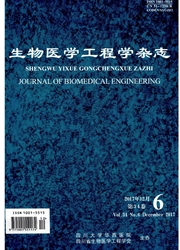

 中文摘要:
中文摘要:
配制了与人体软组织性能相近的水凝胶人造软组织。采用由光学平台、相机及支架、相机光源等组成的图像采集设备,记录嵌入在软组织内标识物的连续位移,研究穿刺过程中软组织的变形规律。在分析标识物在X方向和Y方向上位移的基础上,基于反向传播(BP)神经网络,建立标识物在Y方向上的神经网络模型。通过与实验数据对比,神经网络模型的拟合度在95%以上,有效数据的最大相对误差控制在30%,最大绝对误差为0.8mm,能够较好地定量预测穿刺过程中软组织的变形。研究结果可有效提高软组织针穿刺靶点精度。
 英文摘要:
英文摘要:
Polyvinyl alcohol (PVA) hydrogel was made for simulating human's soft tissue in our experiment. The image acquisition device is composed of an optical platform, a camera and its bracket and a light source. In order to study the law of soft tissue deformation under flexible needle insertion, markers were embedded into the soft tissue and their displacements were recorded. Based on the analysis of displacements of markers in X direction and Y direction, back propagation (BP) neural network was employed to model the displacement of Y direction for the markers. Compared to the experimental data, fitting degree of the neural network model was above 95% the maximum relative error for valid data was limited to 30 %, and the maximum absolute error was 0.8 mm. The BP neural network model was beneficial for predicting soft tissue deformation quantitatively. The results showed that the model could effectively improve the accuracy of flexible needle insertion into soft tissue.
 同期刊论文项目
同期刊论文项目
 同项目期刊论文
同项目期刊论文
 期刊信息
期刊信息
